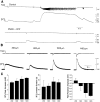Synchronous GABA-mediated potentials and epileptiform discharges in the rat limbic system in vitro
- PMID: 8656285
- PMCID: PMC6578615
- DOI: 10.1523/JNEUROSCI.16-12-03912.1996
Synchronous GABA-mediated potentials and epileptiform discharges in the rat limbic system in vitro
Abstract
Application of 4-aminopyridine (4AP, 50 microM) to combined slices of adult rat hippocampus-entorhinal cortex-induced ictal and interictal epileptiform discharges, as well as slow field potentials that were abolished by the mu-opioid agonist [D-Ala2,N-Me-Phe4,Gly-ol5] enkephalin (DAGO, 10 microM) or the GABAA receptor antagonist bicuculline methiodide (BMI, 10 microM); hence, they represented synchronous GABA-mediated potentials. Ictal discharges originated in the entorhinal cortex and propagated to the hippocampus, whereas interictal activity of CA3 origin was usually recorded in the hippocampus. The GABA-mediated potentials had no fixed site of origin or modality of propagation; they closely preceded (0.2-5 sec) and thus appeared to initiate ictal discharges. Only ictal discharges were blocked by the antagonist of the NMDA receptor 3,3-(2-carboxypiperazine-4-yl)propyl-1-phosphonate (CPP, 10 microM), whereas the non-NMDA receptor antagonist 6-cyano-7-nitroquinoxaline-2,3-dione (CNQX, 10 microM) abolished all epileptiform activities. The GABA-mediated potentials continued to occur synchronously in all regions even after concomitant application of CNQX and CPP. [K+]o elevations were recorded in the entorhinal cortex during the ictal discharge (peak values = 13.9 +/- 0.9 mM) and the synchronous GABA-mediated potentials (peak values = 4.2 +/- 0.1 mM); the latter increases were presumably attributable to postsynaptic GABAa-receptor activation because they were abolished by DAGO or BMI. Their role in initiating ictal activity was demonstrated by using DAGO, which abolished both GABA-mediated synchronous potentials and ictal discharges. These data indicate that NMDA-mediated ictal discharges induced by 4AP originate in the entorhinal cortex; such a conclusion is in line with clinical evidence obtained in temporal lobe epilepsy patients. 4AP also induces GABA-mediated potentials that spread within the limbic system when excitatory transmission is blocked and may play a role in initiating ictal discharge by increasing [K+]o.
Figures









References
-
- Andersen P, Holmqvist B, Voorhoeve PE. Entorhinal activation of dentate granule cells. Acta Physiol Scand. 1966a;66:448–460. - PubMed
-
- Andersen P, Holmqvist B, Voorhoeve PE. Excitatory synapses on hippocampal apical dendrites activated by entorhinal stimulation. Acta Physiol Scand. 1966b;66:461–472. - PubMed
-
- Andersen P, Bliss VP, Skrede KK. Lamellar organization of hippocampal excitatory pathways. Exp Brain Res. 1971;13:222–238. - PubMed
-
- Avoli M, Drapeau C, Louvel J, Pumain R, Olivier A, Villemure J-G. Epileptiform activity induced by low extracellular magnesium in the human cortex maintained in vitro. Ann Neurol. 1991;30:589–596. - PubMed
-
- Avoli M, Psarropoulou C, Tancredi V, Fueta Y. On the synchronous activity induced by 4-aminopyridine in the CA3 subfield of juvenile rat hippocampus. J Neurophysiol. 1993;70:1018–1029. - PubMed
Publication types
MeSH terms
Substances
Grants and funding
LinkOut - more resources
Full Text Sources
Medical
Research Materials
Miscellaneous
